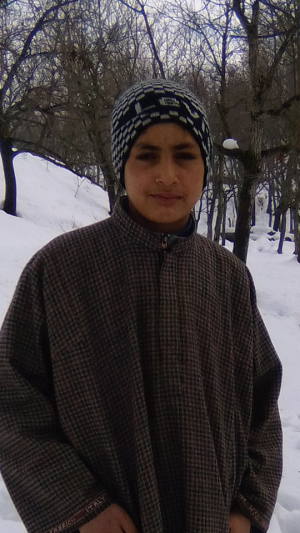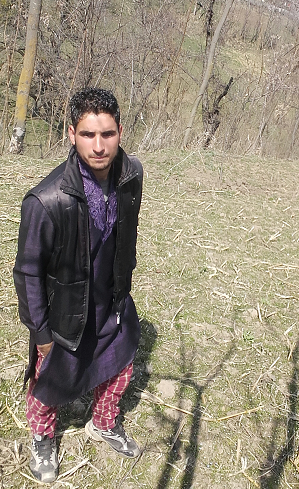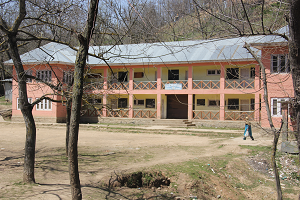Online or Offline, Protest Goes On
Srinagar, J&K: Ahead of the Srinagar parliamentary by-polls held on 9 April 2017, the Jammu & Kashmir state government suspended mobile data services to prevent protests around the election. The constituency went to polls with strict restrictions on movement, and with no access to mobile internet. As soon as the electoral staff reached their respective polling booths, however, there were protests. People at dozens of locations in central Kashmir’s Budgam district began to gather to demonstrate against the central and state governments, which they believed had not safeguarded Kashmiri interests.
 Faizan, a 12-year-old schoolboy, was killed in the Dalwan shooting |
 Abbas, 21, was one of the victims of the shooting in Dalwan |
 Abbas’ home in Dalwan |
 The school in Dalwan where the shooting occurred |
Picture Courtesy: Junaid Nabi Bazaz
In Dalwan village, a picture-postcard village atop a hill 35 kms from Budgam town, no votes were cast: the officers fled the polling station, and the paramilitary forces and police shot at protesters. Two people – a 21-year-old son of a policeman and a 12-year-old schoolboy – died on the spot.
People of Dalwan have been voting in droves in every parliamentary, legislative and local body election, even on occasions where much of Kashmir boycotted polls. But in April, residents said they were fed up with legislators not working to ensure uninterrupted power, water supply, concrete roads, or even a permanent doctor at its only dispensary. So, a village that has never demonstrated or produced any militants in the last 30 years of uprisings in the Kashmir Valley erupted in protest that election day. Now, the cemetery in which the two killed civilians are buried has been renamed as Martyr’s Graveyard.
Bazil Ahmad, a resident of Dalwan, says that nothing could have prevented the protests that day. “We protested against state, it was a spontaneous response,” says 22-year-old Ahmad who threw his first stones that day. “If the government believes that an internet blockade could prevent protests, they’re living in a fool’s paradise.” He sees the internet only as a free platform to express his anger and disappointment. “The actual trigger for the anger comes from the denial of rights and state aggression, not because of the internet,” says Ahmad.
As the news about the killings spread to neighbouring villages word-of-mouth, residents there too protested. Journalists in these villages updated their newsrooms. In a few days, all newspapers in Kashmir carried the news of eight deaths, scores of injuries, and the appalling 6.5% voter turnout in Budgam and Ganderbal districts.
After the ban was lifted, videos captured on polling day were posted on Facebook, Twitter and WhatsApp. One of them was a video of Farooq Dar, a voter returning from the polling booth, tied to the front bumper of a military vehicle as it patrolled villages. A paper with his name was tied to his chest, and a soldier announced on the loudspeaker, “Look at the fate of the stonepelter.” The video created an uproar internationally. The armed forces were accused of using a civilian as “a human shield”, pushing it to hold an inquiry, and the police to lodge an FIR.
After these videos emerged, the government on April 26 officially banned 22 social media sites and apps, including Facebook, WhatsApp and Twitter, for over a month. Once again, it seemed to have little effect on the protests – and protestors.
Sajad, who has been throwing stones for the past eight years at the armed forces, says, “The government is miscalculating the use of internet and the occurrence of protests.” The 28-year-old refers to the protests using the Kashmiri phrase kani jung, loosely translated as ‘stone battle’, which to him conveys a revolutionary zeal. Youths like Sajad who participate in the protests insist that they are provoked each time by an instance of human rights violation that exacerbates the long experience of militarisation, aspiration for “azadi”, and conflict in Kashmir. Internet shutdowns do nothing to erase this trigger, he says, and sometimes heighten their anger.
In just 2017, there have been 27 internet or social media bans in J&K, according to internetshutdowns.in. In the absence of evidence or study about its effects, it’s unclear if these blockades curb the spread of misinformation at all, or prevent the mobilisation of people for protests. For instance, on 15 April 2017, students from Degree College in south Kashmir’s Pulwama district protested against the armed forces for firing teargas and beating them. Though there was an internet ban in place, the incident went live on Facebook. It led to more student protests across the state. Schools, colleges and universities had to be closed for weeks.
Due to the frequency of blockades, several Kashmiris, including ministers, bureaucrats, civilians, protesters and police officers, have found a way out: they have turned to VPNs (Virtual Private Networks).
A VPN allows users to remain secure online and also enables them to access content or websites that are otherwise blocked. Sajad says, "A selective ban on the internet does not help, because we use VPNs. A person gains access to a network, and everyone in the area finds out how. Let the government block everything, it won’t stop protests.” To illustrate his point, Sajad gives the example of uprisings in the summer of 2016, during which internet, pre-paid and post-paid connections were shut for months. “Were there not protests?” he asks. “Kashmir was resisting Indian forces even before the internet existed, so why would it be difficult for us to use the same means now?”
Gulzar, a 30-year-old who has joined protests since he was 15, says the internet is more often used to disseminate information about the injustice, and not to organise protests. “A guy from Srinagar will only protest in Srinagar, and not go to other places. So, it is not too difficult to find out where protests are going on,” says Gulzar.
A DSP-rank police officer in the cyber crime cell of the J&K Police, on the condition of anonymity, says that bans have not yielded absolute results, but have been useful in preventing small-scale protests. He cited the example of district-level territorial internet blockades, done during gunfights between militants and the armed forces, to prevent immediate information sharing that may lead to the operation being compromised. “Say some militants are caught during an encounter in a village in Pulwama district. We block the internet as a precautionary measure in that area,” he says. “In case the district is violence-free, we reduce the bandwidth. That has now become the standard operating procedure.”
The police officer adds that accustomed to the bans, people now record the protests and later post videos on social media once the ban is lifted. “So, in effect, what the internet ban achieved is neutralised as soon as the internet is back on,” he says.
Names changed to protect identity.
Junaid Nabi Bazaz is a Srinagar-based journalist and a member of 101Reporters.com, a pan-India network of grassroots reporters. He has been working as a journalist in Kashmir since 2010. He has covered human rights, economy, administration, crime and health over these years. He has also written for contributoria.com, an independent division of The Guardian.
Shutdown stories are the output of a collaboration between 101 Reporters and CIS with support from Facebook.



